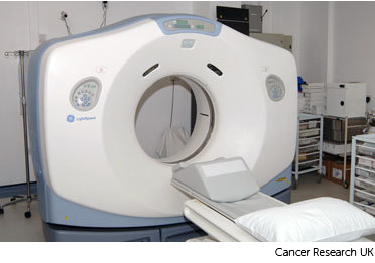Planning external radiotherapy
You might have external radiotherapy for a neuroendocrine tumour (NET) that has spread to other parts of the body such as the bones and the brain. It can control your symptoms and help you feel better.
Planning your treatment
The radiotherapy team plan your external radiotherapy before you start treatment. This means working out the dose of radiotherapy you need and exactly where you need it.
Your planning appointment takes from 15 minutes to 2 hours.
You usually have a planning CT scan in the radiotherapy department.
The scan shows the cancer and the area around it. You might have other types of scans or x-rays to help your treatment team plan your radiotherapy. The plan they create is just for you.

Your radiographers tell you what is going to happen. They help you into position on the scan couch. You might have a type of firm cushion called a vacbag to help you keep still.
The CT scanner couch is the same type of bed that you lie on for your treatment sessions. You need to lie very still. Tell your radiographers if you aren't comfortable.
Injection of dye
You might need an injection of contrast into a vein in your hand. This is a dye that helps body tissues show up more clearly on the scan.
Before you have the contrast, your radiographer asks you about any medical conditions or allergies. Some people are allergic to the contrast.
Having the scan
Once you are in position your radiographers put some markers on your skin. They move the couch up and through the scanner. They then leave the room and the scan starts.
The scan takes about 5 minutes. You won't feel anything. Your radiographers can see and hear you from the CT control area where they operate the scanner.
Making a mould or shell
You need to keep still during radiotherapy. If you have radiotherapy to the brain, your treatment team might make a mould (shell) for you to wear during the treatment sessions. The shell covers the whole of your face and the front of your head. And it attaches to the scanner or radiotherapy machine bed while you are wearing it. This means that you can’t move, but there is nothing attached to you directly.
The radiographers may also make marks on the shell. They use the marks to line up the radiotherapy machine for each treatment.
The process of making the shell can vary slightly between hospitals. It usually takes around 30 minutes.
Before making the shell
You need to wear clothes that you can easily take off from your neck. You also need to take off any jewellery from that area.
Facial hair, long hair or dreadlocks can make it difficult to mould the shell. The radiotherapy staff will tell you if you need to shave or tie your hair back.
Making the shell
A technician uses a special kind of plastic that they heat in warm water. This makes it soft and pliable. They put the plastic on to your face and neck so that it molds exactly.
After a few minutes the plastic gets hard. The technician takes the shell off and it is ready to use.
Voiceover: Making a mesh mask for radiotherapy takes a few minutes
Radiographer: I am just going to heat this up now if you just keep nice and still there and just want to close your eyes for us
Voiceover: The radiographer softens the mask by putting it in warm water for a minute or two. When the radiographer puts the mask on to your face it will feel warm and damp. They then clip it to the bed that you are lying on. It takes a minute or two to dry into the shape of your face. The radiographers will mark the mask where the light lines are.
Radiographer: Ok, you are just going to feel us pressing down on the mask there; you are doing really well are you still ok?
Patient: mmm
Voiceover: They use the marks on the mask to line up the machine each time you have treatment. The mask keeps you head still and makes sure that your treatment is directed at the cancer. They put your name on the mask and keep it in the radiotherapy department ready for your treatment
Patient: They um told me about the procedure, a mask being fitted, uumm that it would be moulded to the shape of my face. Umm which they did, three lovely girls umm put my mind at ease sat me down heated the mask moulded it around my face um not an uncomfortable thing at all to go through
After your planning session
You might have to wait a few days or up to 3 weeks before you start treatment.
During this time the physicists and your radiotherapy doctor (clinical oncologist) decide the final details of your radiotherapy plan. They make sure that the area of the cancer will receive a high dose and nearby areas receive a low dose. This reduces the side effects you might get during and after treatment.
This page is due for review. We will update this as soon as possible.



